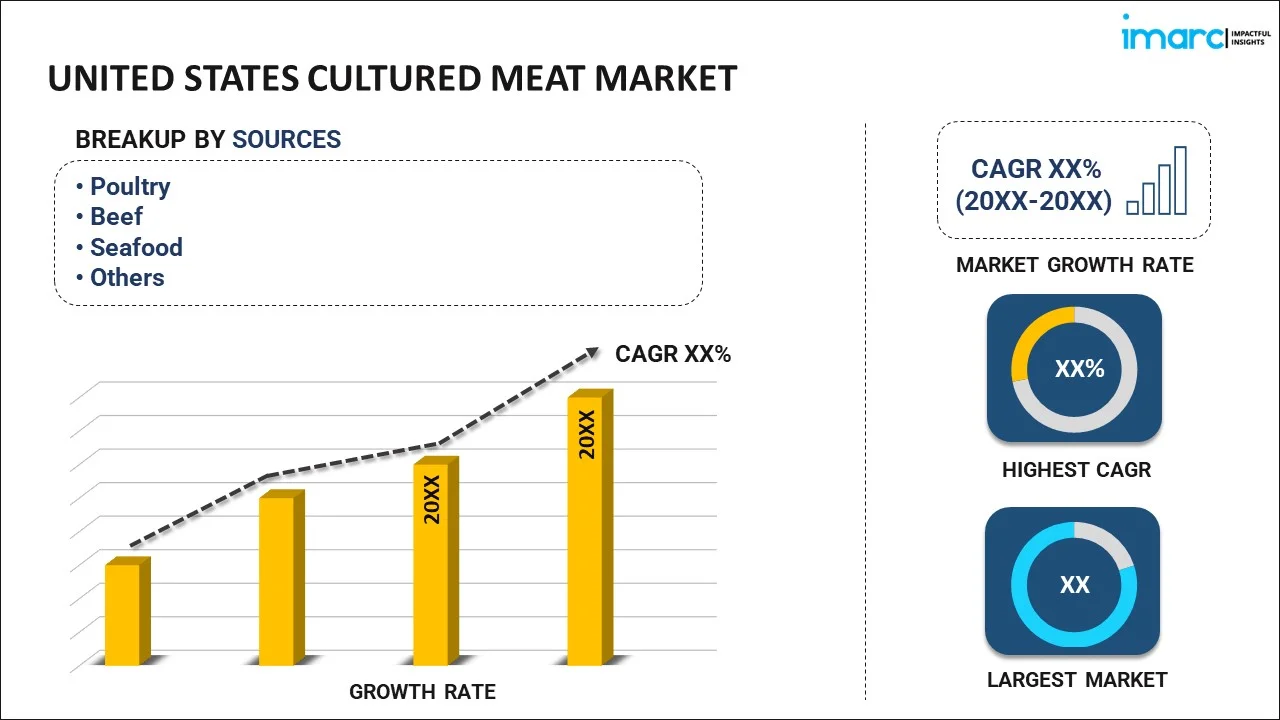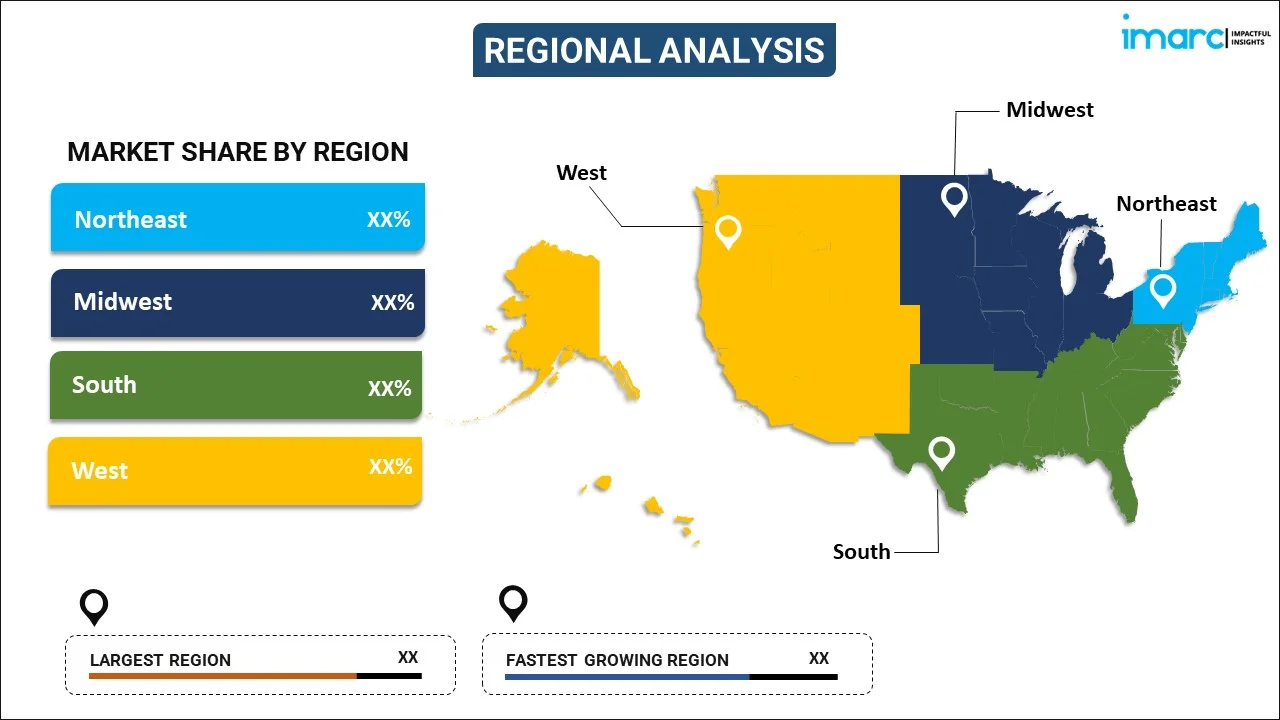
United States Cultured Meat Market Report by Source (Poultry, Beef, Seafood, Pork, Duck), Application (Nuggets, Burgers, Meatballs, Sausages, Hot Dogs), End User (Household, Food Services), and Region 2024-2032
Market Overview:
United States cultured meat market size reached US$ 71.09 Million in 2023. Looking forward, IMARC Group expects the market to reach US$ 1,341.84 Million by 2032, exhibiting a growth rate (CAGR) of 36.50% during 2024-2032. The ongoing advancements in tissue engineering, biotechnology, and cell culture techniques, which can make the cultured meat production more scalable and cost-effective, are driving the market.
|
Report Attribute
|
Key Statistics
|
|---|---|
|
Base Year
|
2023
|
|
Forecast Years
|
2024-2032
|
|
Historical Years
|
2018-2023
|
|
Market Size in 2023
|
US$ 71.09 Million |
|
Market Forecast in 2032
|
US$ 1,341.84 Million |
| Market Growth Rate 2024-2032 | 36.50% |
Cultured meat, also known as lab-grown or cell-based meat, is a revolutionary approach to producing meat products without traditional animal farming. It involves cultivating animal cells in a controlled environment, such as a bioreactor, where they multiply and develop into muscle tissue. This process mimics the natural growth of meat inside an animal but occurs outside the animal's body. Researchers harvest a small sample of animal cells and provide them with the necessary nutrients to encourage growth. The result is a product that closely resembles conventionally produced meat, both in taste and texture. Cultured meat has the potential to address various ethical, environmental, and sustainability concerns associated with traditional meat production, including the reduction of greenhouse gas emissions, land use, and animal welfare issues. As technology advances, the development of cultured meat continues to gain momentum, offering a promising alternative to conventional livestock farming.
United States Cultured Meat Market Trends:
The cultured meat market in the United States is rapidly expanding, driven by a confluence of factors that underscore its potential to revolutionize the regional food industry. Firstly, heightened environmental consciousness has propelled the demand for sustainable food sources. Consequently, cultured meat, produced with significantly lower environmental impact compared to traditional livestock farming, is gaining traction as a viable solution. Moreover, the growing population and increasing urbanization have led to a surge in demand for protein-rich diets, amplifying the appeal of cultured meat as a resource-efficient alternative. Furthermore, advancements in biotechnology and tissue engineering are pivotal drivers in the cultured meat market. Ongoing R&D efforts have resulted in improved production efficiency, cost reduction, and enhanced taste and texture, addressing key consumer concerns. Additionally, the rise of ethical considerations related to animal welfare, which has positioned cultured meat as an ethical and cruelty-free protein source, resonating with consumers who seek ethical choices in their dietary preferences, is expected to drive the cultured meat market in the United States during the forecast period.
United States Cultured Meat Market Segmentation:
IMARC Group provides an analysis of the key trends in each segment of the market, along with forecasts at the country level for 2024-2032. Our report has categorized the market based on source, application, and end user.
Source Insights:

- Poultry
- Beef
- Seafood
- Pork
- Duck
The report has provided a detailed breakup and analysis of the market based on the source. This includes poultry, beef, seafood, pork, and duck.
Application Insights:
- Nuggets
- Burgers
- Meatballs
- Sausages
- Hot Dogs
A detailed breakup and analysis of the market based on the application have also been provided in the report. This includes nuggets, burgers, meatballs, sausages, and hot dogs.
End User Insights:
- Household
- Food Services
The report has provided a detailed breakup and analysis of the market based on the end user. This includes household and food services.
Regional Insights:

- Northeast
- Midwest
- South
- West
The report has also provided a comprehensive analysis of all the major regional markets, which include Northeast, Midwest, South, and West.
Competitive Landscape:
The market research report has also provided a comprehensive analysis of the competitive landscape in the market. Competitive analysis such as market structure, key player positioning, top winning strategies, competitive dashboard, and company evaluation quadrant has been covered in the report. Also, detailed profiles of all major companies have been provided.
United States Cultured Meat Market Report Coverage:
| Report Features | Details |
|---|---|
| Base Year of the Analysis | 2023 |
| Historical Period | 2018-2023 |
| Forecast Period | 2024-2032 |
| Units | US$ Million |
| Scope of the Report | Exploration of Historical and Forecast Trends, Industry Catalysts and Challenges, Segment-Wise Historical and Predictive Market Assessment:
|
| Sources Covered | Poultry, Beef, Seafood, Pork, Duck |
| Applications Covered | Nuggets, Burgers, Meatballs, Sausages, Hot Dogs |
| End Users Covered | Household, Food Services |
| Regions Covered | Northeast, Midwest, South, West |
| Customization Scope | 10% Free Customization |
| Report Price and Purchase Option | Single User License: US$ 3699 Five User License: US$ 4699 Corporate License: US$ 5699 |
| Post-Sale Analyst Support | 10-12 Weeks |
| Delivery Format | PDF and Excel through Email (We can also provide the editable version of the report in PPT/Word format on special request) |
Key Questions Answered in This Report:
- How has the United States cultured meat market performed so far and how will it perform in the coming years?
- What has been the impact of COVID-19 on the United States cultured meat market?
- What is the breakup of the United States cultured meat market on the basis of source?
- What is the breakup of the United States cultured meat market on the basis of application?
- What is the breakup of the United States cultured meat market on the basis of end user?
- What are the various stages in the value chain of the United States cultured meat market?
- What are the key driving factors and challenges in the United States cultured meat?
- What is the structure of the United States cultured meat market and who are the key players?
- What is the degree of competition in the United States cultured meat market?
Key Benefits for Stakeholders:
- IMARC’s industry report offers a comprehensive quantitative analysis of various market segments, historical and current market trends, market forecasts, and dynamics of the United States cultured meat market from 2018-2032.
- The research report provides the latest information on the market drivers, challenges, and opportunities in the United States cultured meat market.
- Porter's five forces analysis assist stakeholders in assessing the impact of new entrants, competitive rivalry, supplier power, buyer power, and the threat of substitution. It helps stakeholders to analyze the level of competition within the United States cultured meat industry and its attractiveness.
- Competitive landscape allows stakeholders to understand their competitive environment and provides an insight into the current positions of key players in the market.
Need more help?
- Speak to our experienced analysts for insights on the current market scenarios.
- Include additional segments and countries to customize the report as per your requirement.
- Gain an unparalleled competitive advantage in your domain by understanding how to utilize the report and positively impacting your operations and revenue.
- For further assistance, please connect with our analysts.
 Inquire Before Buying
Inquire Before Buying
 Speak to an Analyst
Speak to an Analyst
 Request Brochure
Request Brochure
 Request Customization
Request Customization




.webp)




.webp)












